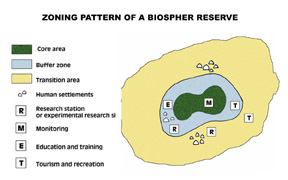Biosphere Reserves Concept: What is a Biosphere Reserve?
Biosphere Reserves are geographical areas that represent Earth’s diversity of habitats. These areas consist of protected areas as well as sustainable human settlements, who do not endanger the ecology of the site.
Biosphere Reserves are terrestrial and coastal ecosystems that promote conservation and sustainable use of biodiversity. They are nominated by national governments and internationally recognized within the framework of UNESCO’s Man and Biosphere (MAB) programme. Biosphere reserves act as “living laboratories”.
The definition of biosphere Reserves (BRs) according to MOEF is : those representative parts of natural and cultural landscapes extending over large area of terrestrial or coastal or marine ecosystems or their combination, representative of those bio-geographic zones/provinces.
Man and the Biosphere (MAB) Programme
Man and Biosphere programme is an Intergovernmental Scientific Programme to study our impact on nature and how it can be minimized. It was launched in 1971. Popularly referred to as MAB. The Man and Biosphere Programme completed 40 years in 2011.
The idea of the biosphere reserve was initiated by UNESCO (United Nations Educational, Scientific and Cultural Organisation) in 1970 under its Man and Biosphere Programme (MAB). The purpose of biosphere reserves programme was to obtain international cooperation for their conservation and research.
Objectives of Biosphere Reserves
The biosphere reserve should fulfill the following three objectives:
- In-situ conservation of biodiversity belonging to natural, semi-natural ecosystems and landscapes.
- Contribution to sustainable economic development of the human population housed within and around.
- Provide logistical facilities for long term ecological studies, environmental education and training and research and monitoring.
Biosphere Reserves of India
The Ministry of Environment and Forest provides financial assistance to State governments for conservation of landscape, diversity and cultural heritage. Ministry also provides support for research, monitoring, education and information exchange of the respective biosphere reserve.
The Indian government has established 18 Biosphere Reserves in India. These biosphere reserves often include one or more National Parks and Reserves, along buffer zones that are open to some economic uses. Here, protection is granted to the flora and fauna of the region, along with the human communities inhabiting the biosphere reserves and their ways of life.
Latest List of Biosphere Reserves in India: Major Flora Fauna
|
S.No. |
Name |
Location of Biosphere Reserve in India |
State |
Key Fauna |
Key Flora |
| 1 | The Great Rann of Kutchh | Part of Kutch, Rajkot, Surendranagar and Patan Districts | Gujarat | Indian Wild Ass | |
| 2 | Gulf of Mannar | Indian part of Gulf of Mannar extending from Rameswaram island in the North to Kanyakumari in the South of Tamil Nadu and Sri Lanka | Tamil Nadu | Dugong Dugong (Sea Cow), Sea Fan | Morning glory, Halophila grass |
| 3 |
Sundarbans Biosphere Reserve
(largest contiguous mangrove area in the world and only mangrove area having Tigers) |
Royal Tiger Reserve, Sundarban National Park and three Wildlife sanctuaries- Sajnekhali, Lothian Island, Holiday Island. | West Bengal | Bengal Tiger, Salvator lizard, Bengal monitor lizard | Sundari, Nypa, Passur, Tagal mangrove, Sandy mangrove, crabapple mangrove |
| 4 | Cold Desert | Pin Valley National Park and surroundings; Chandratal and Sarchu & Kibber Wildlife Sancturary | Himachal Pradesh | Snow Leopard | |
| 5 | Nanda Devi Biosphere Reserve |
Includes Nanda Devi National Park and Valley of Flowers National Park covering parts of Chamoli, Pithoragarh & Bageshwar Districts
(Temperate forest, sub-alpine forest and alpine land) |
Uttarakhand | Himalyan Tahr, Koklas pheaant, Brown Bear | Silver weed, Fairy Primrose, Salep orchid |
| 6 |
Nilgiri Biosphere Reserve
(First Biosphere Reserve in India) |
Waynad and Mudumalai Wildlife Sanctuary, National Parks – Bandipur, Nagarhole, Mukurti, Silent Valley and Siruvani Hills
(Malabar Rain Forest) |
Tamil Nadu, Kerala and Karnataka | Nilgiri Tahr, Lion-tailed macaque, Nilgiri langur | Vanda, Liparis, Medusa’s head orchid, Spiranthes, Chi-tou wind orchid |
| 7 | Dihang-Dibang | Part of Siang and Dibang Valley | Arunachal Pradesh | Red panda, green pit viper, Takin | Tree fern, Begonia |
| 8 | Pachmarhi Biosphere Reserve | Bori Sanctuary, Pachmarhi Sanctuary, and Satpura National Park | Madhya Pradesh | Barasinga, Wild Buffalo, Red jungle fowl | Sal tree, Selaginella fern, Palimorpha bamboo |
| 9 | Seshachalam Hills | Seshachalam Hill Ranges. Sri Venkateshwara National Park form core zone and Tirumala Temple complex is part of transition zone | Andhra Pradesh | Slender Loris | Red Sanders |
| 10 | Simlipal |
Eastern Plateau, Chotanagpur Plateau, Lower Gangetic Plain and Coastline biotic areas
|
Odisha | Red breasted Falconet, Ruddy mangoose | Colix grass, Sal tree, Myrobalan, Sisso, Champak |
| 11 | Achanakamar – Amarkantak | Part of Annupur, Dindoriand Bilaspur districts | Madhya Pradesh, Chhattisgarh | Fourhorn Antelope, Saras crane, Sacred grove bush Frog, Whitebacked Vulture, Indian wild dog | |
| 12 | Manas | Part of Kokrajhar, Bongaigaon, Barpeta, Nalbari, Kamrup and Darrang Districts
(Rain Forest biome and grassland savannah biome) |
Assam | Pygmy hog, Hispid hare, Golden langur | Catechu tree, Sissoo, white siris |
| 13 | Khangchendzonga | Parts of Kanchanjunga Hills | Sikkim | Snow Leopard, Red Panda | |
| 14 | Agasthyamalai Biosphere Reserve | Neyyar, Peppara and Shendurney Wildlife Sanctuary and Kalakad Mundanthurai Tiger reserve | Kerala, Tamil Nadu | Lion tailed macaque, slender loris, Great pied hornbill | Rudraksha tree, Gaub tree, Wild dhaman, black plums |
| 15 | Great Nicobar Biosphere Reserve | Southern most islands of Andaman and Nicobar Islands | Andaman and Nicobar Islands | Serpent Eagle, Crab eating Macaque, saltwater Crocodile | Screw pine, Nipa Palm, Ceylon iron wood |
| 16 | Nokrek Biosphere Reserve |
Part of East Garo Hills, West Garo Hills, and South Garo Hills. Nokrek National Park is the core of reserve.
(Tropical and Sub-tropical vegetation) |
Meghalaya | Pig tailed macaque, Giant Flying squirrel, Stump tailed macaque | Grand rasamala, Hairy Sterculia, Wild lemon, Chempaka, White meranti |
| 17 | Dibru-Saikhowa | Part of Dibrugarh and Tinsukia districts | Assam | Golden Langur, Hollock gibbon | Rauvolfia, Benteak, Livistona orchid |
| 18 | Panna | Part of Panna and Chattarpur Districts
(Arid and Semi Arid) |
Madhya Pradesh | tiger, chital, chinkara, sambhar and sloth bear |
Indian Biosphere Reserves in UNESCO list World network
The Biosphere Reserves in India in UNESCO list are listed below in green color and bold. There are 10 biosphere reserves listed in UNESCO world network from India. They are Agasthyamalai, Nilgiri, Gulf of Mannar, Sunderban, Nanda Devi, Nokrek, Pachmarh, Similipal, Achanakmar-Amarkantak and Great Nicobar.
Agasthyamalai Biosphere Reserve is the latest one to be included in the UNESCO’s World network of biosphere reserves. This is tenth BR to be included in UNESCO list in 2016.
Criteria for designation of Biosphere Reserves
A site must contain an effectively protected and minimally disturbed core area of value of nature conservation. The core area should be able to sustain viable populations representing all trophic levels in the ecosystem. The area should have potential for preservation of traditional tribal or rural modes of living for harmonious use of the environment.
Zones in a Biosphere Reserve

Biosphere Reserves Zones
- Core area – Comprises a strictly protected ecosystem that contributes to the conservation of landscapes, ecosystems, species and genetic variation
- Buffer zone – It surrounds the core areas, and is open for sustainable activities and ecological practices that can reinforce scientific research, monitoring, training and education
- Transition area – It is part of the reserve where the greatest activity is allowed, fostering economic and human development that is socioculturally and ecologically sustainable.
The activities permitted under the Biosphere reserves scheme are :
To reduce biotic pressure on biodiversity of the core zone in the biosphere reserves, emphasis is on welfare of local inhabitants. Through provisions of supplementary and alternate livelihood support to the people living in the buffer and transition zones.
- Value addition activities
- Sustainable use of threatened resources
- Rehabilitation of landscapes of threatened species and ecosystems
- Socio-economic upliftment of local communities inhabiting the area
- Maintenance and protection of corridor areas for enabling movement
- Development of communication system and Networking in the region for research and monitoring
- Development of Eco-tourism





This gives me complete information about all important biosphere reserves and species in them !
Good material for beginners
Thank you Venkat for the appreciation. Your feedback helps us grow our content. Please do share any suggestions if you have any.
And keep visiting us :)
Nnice article
Thank you Sachin for appreciating the work.
Keep visiting exampariksha for more such articles. You can also suggest topics to us.
Nice presentation ma’am
Thank u very much for the most crisp information….very handy…thanks once again